How to prevent and treat ingrown toenails
Ingrown toenails are painful and, if not properly treated, can lead to infection. How do you recognize them? What causes them? Can they be prevented? And, most important, how can you treat them? Get the answers in this article!

Symptoms
Ingrown toenails are so named because they grow into the skin. While the condition can occur on any toe, it is more likely to affect the big toes.
When a toenail starts digging into the skin, it can result in these symptoms:
- Pain aggravated by pressure
- Redness, warmth and swelling
- Pus
 If left untreated, ingrown toenails can get worse, resulting in extra tissue growth, which can cause pain, bleed easily and possibly get infected.
If left untreated, ingrown toenails can get worse, resulting in extra tissue growth, which can cause pain, bleed easily and possibly get infected.
Risk factors
Various factors are involved in the development of ingrown toenails, including:
- Toenails cut too short or with round edges
- Damaged or poorly cared for toenails
- Shoes that are too small, too narrow or high heeled
- Excessive foot perspiration, which softens the skin
- Curvature, growth and thickness of a nail
- Genetics
- Osteoarthritis in the toes
Prevention
Given the risk factors, it is easy to determine the measures needed to avoid this unpleasant condition:

- Trim your toenails straight across, never shorter than the end of your toe, using nail scissors rather than a nail clipper.
- File down uneven nails.
- Choose properly fitting footwear appropriate to the activity you are engaged in.
- Reduce excessive foot perspiration by wearing shoes and socks made of breathable material and, if necessary, by asking your family pharmacist for advice.
Treatments
You can self-treat an ingrown toenail. Here is how:
- Soak your feet in lukewarm water and antiseptic soap or salt for fifteen minutes or so.
- Dry your feet thoroughly.
- Insert a piece of sterile cotton under the corner of the ingrown nail and gently lift it, using a pair of tweezers, for example.

- Apply an antibiotic cream or ointment to the affected area.
- Repeat once or twice a day until the nail has sufficiently grown to be cut straight across.
Keep in mind that if there is infection, if the problem recurs or if you have diabetes, it is better to consult a doctor or podiatrist to get help in dealing with the issue and avoid the risk of complications.
In certain cases, minor surgery under local anesthetic may be performed. This permanent treatment involves removing a narrow strip of nail, including the nail root. It will then be destroyed with a chemical, such as phenol, to prevent the affected nail from growing back.
Pharmacy services
Over-the-counter foot care products to ease and treat foot problems are safe and effective when used according to directions. They may not be suitable for everyone, however, especially for people with diabetes.
Before using any such products for the first time, speak with your family pharmacist, who can advise you on their use, along with precautions and contraindications.
The pharmacy services presented in this section are offered by pharmacist owners who are affiliated with Uniprix. The pharmacists are solely responsible for the professional activities carried out during the practice of pharmacy. These services are offered in participating pharmacies only. Certain fees and conditions may apply.
* The information contained herein is provided for informational purposes only and is not intended to provide complete information on the subject matter or to replace the advice of a health professional. This information does not constitute medical consultation, diagnosis or opinion and should not be interpreted as such. Please consult your health care provider if you have any questions about your health, medications or treatment.
